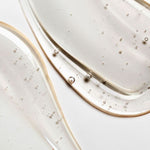EB5 BLOG
Clean in 2017: Part One, Eating Clean

Our word for 2017 is “clean.”January feels like a time to have a fresh start and a clean slate. During the holidays I find there are more and more obligations on the schedule and less and less time for myself. Often things like eating right, exercise and my daily skin routine get bumped for more pressing things like hours of online shopping, a Christmas party or crashing into bed fully clothed after enjoying a few too many hot buttered rums at the aforementioned party. Now that the holidays are over, all of my excuses are, too.
I like that the new year starts in the dead of winter. I’ve never been one to just leap out of bed in the morning or start on the hardest tasks in my to-do list first, so to me, winter feels like a time to move slowly. What this means is that although I may have a long list of things I would like to change for the new year, I don’t start by hitting them hard. It’s my way of being kind to myself while attempting to adjust some bad habits.

In this spirit of starting clean, I did some research into the often-used term, “clean eating” because, to be honest, I wasn’t really sure what it meant. Although I found similar lines of thought throughout, it seems that “clean eating” can mean a variety of things. What I’ve gleaned in a nutshell is that it’s this: avoid eating sugar and ingredients you can’t pronounce. You’ll mostly want to consume whole foods and limiting processed ones. Eat organic when you can. In my research, I came across the term “The Dirty Dozen” many times. If you need to limit your organic supply of food, this term applies to foods that should NOT be skipped. I was surprised to discover that the Dirty Dozen contained many of the fruits and vegetables I eat regularly: strawberries, apples, nectarines, peaches, celery, grapes, cherries, spinach, tomatoes, sweet bell peppers, cherry tomatoes, and cucumbers. On the flipside, if you can’t buy organic, there is the “Clean 15” which contains a few foods that I also eat regularly: avocados, sweet corn, pineapples, cabbage, frozen sweet peas, onions, asparagus, mangoes, papayas, kiwis, eggplant, honeydew melon, grapefruit, cantaloupe, and cauliflower. What’s interesting is that according to the source you are reading, the lists vary. Sometimes potatoes and kale are on the dirty dozen and sometimes sweet potatoes and watermelon are on the clean 15. Even though it doesn’t work for all foods on the list, a good rule of thumb is this: fruits and vegetables with a thick outer layer (like bananas - also commonly on the Clean 15) are less susceptible to pesticides permeating through.
For a lot more information on the Dirty Dozen and Clean 15, the Environmental Working Group’s website is a great resource.







